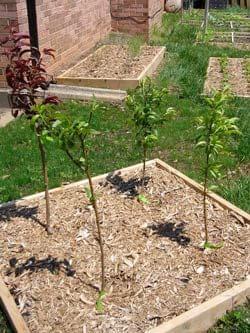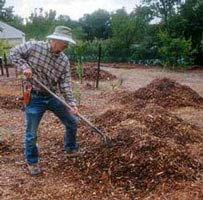We sell our products to retail nurseries, garden centers, container growers who sell to landscape contractors and retail nurseries, mail order nurseries, and anyone else who qualifies. We do not accept direct sales to consumers.
How much water? Why mulch?
For the longest time, gardening and nursery folks have dealt with the Water Problem: "Why is my plant dying? I give it plenty of water."
As all accomplished gardeners know, "plenty of water " can easily be too much water for many plants, especially in slow-draining soils.
How much water?
A poor understanding of how to water a plant, giving too much or too little, is the most common reason why novice gardeners lose plants. Too often, their remedy for a drooping plant is more fertilizer and more water when, in fact, what the plant needs most is less water.
Of course, in sandy, fast-draining soils, neglecting to water, especially during a hot spell, can quickly do irreparable damage to a plant. Easy lesson to learn.
But in clay soils or any poorly-draining soil, the opposite is true: the damage is done by too much water, primarily by denying oxygen to the roots. Plants may decline slowly or suddenly. Fruit trees in wet soils may struggle for years and never perform as they should. In addition, trees stressed by lack of oxygen in the root zone are more susceptible to disease and insect damage.
For any soil, a drip system is an effective and water-efficient way to irrigate fruit trees. Use sufficient emitters to wet the entire area under the canopy to a depth of at least two feet.
Check your soil moisture
Get acquainted with your soil and drainage. Your surface soil moisture might be quite different - wetter or drier - from the soil a foot or more deep.
Your surface soil moisture might be quite different - wetter or drier - from the soil a foot or more deep.
Periodically – including during a hot spell and a few days after a heavy rain or watering - just beyond the edge of a tree's canopy, dig to a depth of a foot or so and actually observe and feel the soil moisture. After you’ve done this a few times, you will begin to develop an instinct as to when your soil is wet and when it is about to become dry.
Observing your trees and other plants as you observe soil moisture will soon give you above-ground indicators. Staying in touch with your soil moisture as the weather fluctuates is an important part of gardening.
Mulch
So what does the drooping plant need? For any soil – fast draining or slow - steady soil moisture and nutrient supply go a long way toward establishing a lush, healthy garden for both fruiting and ornamental plants. And an often over-looked means of getting there is mulching the soil surface.
What’s the deal with mulch? Mulch is good for the soil and the plants. And conserving water. And minimizing the use of synthetic fertilizers.
Mulch, for our purposes, is compost that includes larger particles.
 The use of mulch as a top dressing is an effective way of cutting down water needs. Covering the surface of the soil with mulch lessens the evaporation taking place at the surface. The root zone stays cool, which also cuts down evaporation and extends the time between watering.
The use of mulch as a top dressing is an effective way of cutting down water needs. Covering the surface of the soil with mulch lessens the evaporation taking place at the surface. The root zone stays cool, which also cuts down evaporation and extends the time between watering.
In slow-draining soils, mulch covering the surface gives water more time to penetrate the entire root zone before the top layer becomes dry. In all soils, consistent moisture and a cool root zone reduces the stress to plants in hot weather.
Mulch, as it decomposes, provides a steady source of nutrients to the plants, thereby cutting down the need for and overuse of fertilizers.
And, as it decomposes, mulch provides the soil with organic matter, an essential component of all good garden soils.
Mulch is simple to apply and simple to maintain - a simple remedy to an age-old problem. Look into getting mulch at your local nursery or call around your hometown. Many cities sell mulch very cheaply or even give it away. (They haul all those leaves off the streets and parks and put them somewhere ... )
Don't forget that you can make your own mulch !! There are many different systems for the home gardener and many different web sites: find the one right for you. To make your mulch took pretty, you can use a top dressing: bark (small preferred) straw, alfalfa hay, cocoa bean hulls, wood chips, and oak leaves are some of the materials you can use. You can find top dressing packaged in bags at your local retailer. (If what you see isn’t pretty enough, ask them what else they can obtain.)
Mulch is good for the environment. By using mulch you help cut down on the waste going into landfills. With the concern over nitrates in the ground and water, the use of mulches prepares us for a future when high nitrogen fertilizers are not encouraged. There is not a lot of nitrogen in mulch, and what is there is recycled by the plants rather than finding its way into our water systems.
Finally, and maybe most important, is the need for water conservation. Availability of water for a growing population is more problematic year by year. In order to maintain our gardening lifestyle for decades to come, we all must become aware of how to use water more effectively. Part of the solution is Mulch...Mulch...Mulch...
